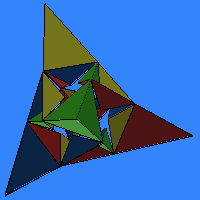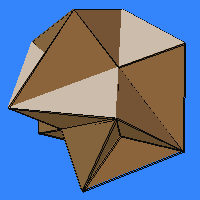Tetrahedral Stellations of the Dodecahedron
- small stellated dodecahedron (mono, method 1, method 2, method 3)
- great dodecahedron (mono, method 1, method 2, method 3)
- great stellated dodecahedron (mono, method 1, method 2, method 3)
- 1. (1) (2)
- 2. (1) (2)
- 3. (1) (2) (3)
- 4. (1) (2)
- 5. (1) (2)
- 6. (1) (2) (3)
- 7. (1) (2)
- 8. (1) (2) (3)
- 9. (1) (2)
- 10. (1) (2) (3)
- 11. (1) (2) (3)
- 12. (1) (2)
 A
(1) (2)
A
(1) (2)- AB (1) (2)
- ABD (1) (2)
- ABDF (1) (2)
- ABE (1) (2)
- ABEF (1) (2)
- ABF (1) (2)
- AC (1) (2) (3)
- ACE (1) (2)
- ACEF (1) (2)
- AD (1) (2)
- ADF (1) (2)
- AE (1, at right) (2)
- AEF (1) (2)
- AF (1) (2)
- B (1) (2) (3)
- BD (1) (2) (3)
- BDE (1) (2)
- BE (1) (2)
- BEF (1) (2) (3)
- D (1) (2)
- DE (1) (2)
- E (1) (2)
- EF (1) (2) (3)
- 0BD (1) (2) (3)
- 0ABD (1) (2)
- 0ABDF (1) (2)
 The
following stellations of the dodecahedron
have tetrahedral symmetry. (The dodecahedron itself and its three well-known
stellations in the Kepler-Poinsot
category have full icosahedral symmetry.) Each is a kind of nonconvex dodecahedron
with twelve identical (disconnected) faces in the face planes of a regular
dodecahedron. Aesthetically, I find that they range from disturbingly like
a caltrop to quite interesting and attractive.
The
following stellations of the dodecahedron
have tetrahedral symmetry. (The dodecahedron itself and its three well-known
stellations in the Kepler-Poinsot
category have full icosahedral symmetry.) Each is a kind of nonconvex dodecahedron
with twelve identical (disconnected) faces in the face planes of a regular
dodecahedron. Aesthetically, I find that they range from disturbingly like
a caltrop to quite interesting and attractive.
The models below are colored in various ways: in solid color, in two different 4-colored arrangements, and sometimes in 6 colors. A tetrahedral 4-coloring of the dodecahedron can either have no adjacent faces of the same color (method 1) or groups of three of the same color (method 2). The 6-coloring (method 3) has opposite faces of a common color. When extending the colored face planes to make a stellation, different colorings bring out different aspects of the structure. One or the other of the two methods will look better depending on the way in which the extended faces meet. (There are also other methods not illustrated here.)
For completeness, here are the three standard icosahedral stellations of the dodecahedron, each in the three coloring methods:
The tetrahedral stellations are now listed in three groups. As with other stellated polyhedra, there is no essential order for listing them. They appear here generally from the core out, but in a no particular order. The first group consists of the twelve fully supported stellations. This means that a line from a point in the stellation to its center never passes through a hollow spot. The figure above shows the one numbered 4 below. Seven of these (numbered 1, 2, 4, 5, 7, 9, 12 below) are chiral and have a mirror image which is not counted in the total of twelve. The other five have three mirror planes; only these are shown in the 6-coloring (method 3).
Be sure and notice how opposite faces are twisted relative to one another in the chiral examples. The one numbered 8 above is discussed in three different references below. It is the only one in which the face planes consist of only one piece. However, what I like the most about it is not mentioned in any reference I know of: It can fill space if you alternate it with a regular dodecahedron.
In addition to the twelve fully supported stellations above, there are the following twenty-four which have hollow centers. The notation here is tentative: A refers to a tetrahedrally arranged chiral group of twelve wedges in four edge-connected groups of three, C is the mirror image of A, and B is the remaining six reflexibly arranged wedges. Similarly, E and F are mirror image tetrahedrally arranged chiral groups of four spikes and D is the remaining reflexible set of twelve spikes. Each of the following tetrahedral stellations of the dodecahedron is given by a subset of these six cells, but many possibilities are not included because either they close off a void in the center or their mirror image is already included. By more stringent rules, some of the following would not be counted, because they can be separated into two subsets (not face-connected) each of which is already counted, e.g., AB is the union of A and B which are only edge-connected. Again, only the reflexible ones are shown in method 3 (6-coloring).
Finally, there are three more which are neither fully supported nor hollow centered:
If you want to quickly make models of these, try the Zometool.
References: Three of these are illustrated in Alan Holden's book Shapes, Space, and Symmetry (p. 90). The one numbered 8 above is illustrated in the paper "An Unfamiliar Dodecahedron" by John Ounsted, in "Duality of Polyhedra" by Grunbaum and Shephard, and in Bonnie Stewart's Adventures among the Toroids (p. 255). I created these with a general-purpose stellation program I have written, which generates many kinds of stellations of all kinds of polyhedra. If you like these, you may also like the tetrahedral stellations of the icosahedron.
Virtual Polyhedra, (c) 1996, George W. Hart